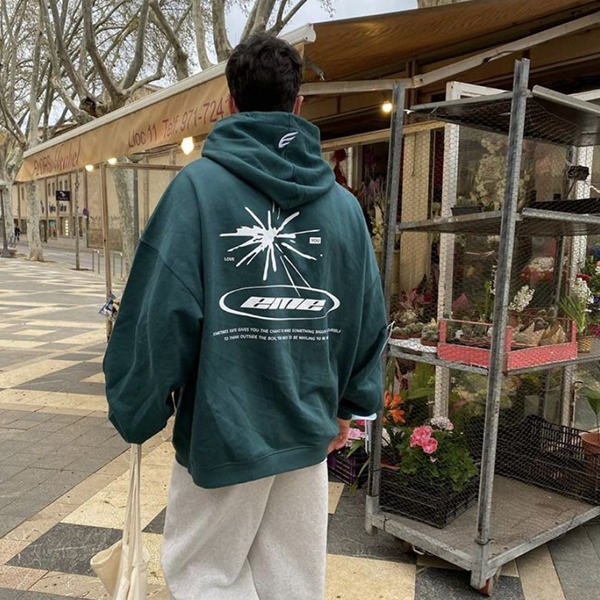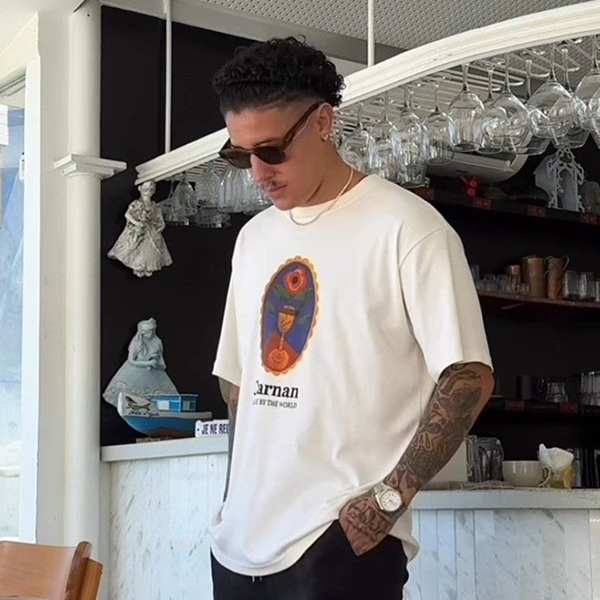There’s a quiet power in the hoodie — a piece that’s equal parts armor and comfort, rebellion and refuge. Once dismissed as “casualwear,” it’s now the most omnipresent garment on the planet. It crosses borders, classes, and subcultures. It’s worn by rappers, tech founders, models, and high-school kids alike.
The hoodie isn’t just fashion — it’s sociology stitched into fleece.
In 2025, the hoodie has achieved what few garments ever could: total cultural transcendence. It’s no longer just about warmth or utility. It’s about identity, belonging, and sometimes, defiance.
1. Origins in Sweat and Steel
Before the hoodie became a runway staple, it was a tool.
Its origins trace back to the 1930s, when Champion created the first hooded sweatshirt for workers in cold warehouses. These garments were functional — designed to keep laborers warm, with hoods to shield them from wind and dust.
It was blue-collar gear. Hardwearing. Honest.
No one imagined it would one day be worn on Paris runways or Milan catwalks.
But like all iconic pieces, the hoodie evolved not through design houses, but through the streets.
By the 1970s and 1980s, hip-hop and graffiti culture had embraced it. For urban youth, the hood wasn’t just warmth — it was anonymity, a shield, a statement. “Don’t mess with me” and “I belong here” in the same breath.
2. From the Margins to the Mainstream
The hoodie’s climb to dominance is the ultimate underdog story.
In the ‘90s, it symbolized rebellion. Rappers like Tupac and Nas wore it as part of a larger message of pride and survival. Skaters and graffiti artists wore it for mobility and attitude.
Then came the backlash. The hoodie was unfairly vilified — banned in malls, associated with delinquency. “Hoodie bans” in the UK and U.S. reflected a deeper social anxiety: when working-class youth and people of color wore it, it was seen as a threat.
But culture doesn’t stay silent.
By the 2000s, the same hoodie was being worn by celebrities, athletes, and designers. Kanye West, Pharrell, and later Virgil Abloh turned it into a canvas of expression.
Tech culture picked it up too. Silicon Valley replaced suits with hoodies — not as rebellion, but as power. Mark Zuckerberg’s hoodie became an emblem of a new corporate identity: informal, efficient, and quietly dominant.
The irony? What was once feared became aspirational.
3. Anatomy of a Modern Hoodie
The hoodie’s enduring power lies in its design simplicity.
It’s just cotton, drawstrings, and a pocket — yet those three elements create something remarkably adaptable.
Modern hoodies have evolved into several archetypes:
- The Street Hoodie — oversized, heavyweight, logo-forward, often layered under coats.
- The Minimalist Hoodie — slim, structured, in neutral tones, worn with tailored trousers.
- The Performance Hoodie — lightweight, technical fabrics for movement and comfort.
- The Statement Hoodie — bold prints, limited releases, and cultural references.
Each serves a different identity, but all retain the same core: protection and ease.
A hoodie feels like armor. The hood shields you from the world, while the soft fabric wraps you in familiarity. It’s both private and public, bold and quiet. That paradox is what keeps it timeless.
4. The Emotional Psychology of the Hood
Every piece of clothing tells a story, but few are as emotionally charged as the hoodie.
The act of pulling up a hood has meaning — it’s introspective.
It says, “I’m here, but I need space.” It’s about control. When the world feels loud, the hoodie offers silence.
There’s comfort in that privacy, especially in a hyper-visible, hyper-digital age.
When every outfit is content and every moment can be broadcast, the hoodie lets you disappear — even for a while.
That’s why creatives, gamers, designers, and thinkers all gravitate toward it. It’s the thinking person’s uniform.
5. The Hoodie in High Fashion
The hoodie’s entry into luxury fashion wasn’t just a trend — it was a cultural acknowledgment.
Designers like Demna (Balenciaga), Virgil Abloh (Off-White), and Matthew Williams (Alyx) redefined its silhouette, elevating fleece into couture. Suddenly, the same item that once cost $20 now appeared on runways for $800.
But what changed wasn’t just price — it was perception.
The hoodie became a metaphor for the shift in fashion’s power structure. Streetwear wasn’t invading luxury; it was the new luxury.
The people who once consumed culture from the outside were now designing it. And the hoodie — the garment of their youth — became their signature.
It symbolized inclusion, progress, and authenticity in an industry long dominated by exclusivity.
6. The Intersection of Gender and Comfort
In 2025, the hoodie is completely genderless.
It’s not “men’s” or “women’s.” It’s everyone’s.
Fashion’s move toward fluidity owes a lot to the hoodie’s neutral appeal. It’s soft, protective, and unstructured — it doesn’t dictate shape or identity.
Women wear oversized hoodies as empowerment. Men embrace fitted versions for comfort. Nonbinary individuals find in it a space of neutrality — a piece that asks no questions, offers no judgment.
That’s the beauty of it: inclusivity without agenda.
7. The Sustainability Shift
Like the T-shirt, the hoodie has also become a battleground for sustainability.
Traditional fleece and cotton blends carry heavy environmental costs, but brands are reimagining production.
Today’s forward-thinking labels — including Trendytroop — invest in:
- Recycled polyester and organic cotton.
- Low-water dyeing methods.
- Circular recycling programs that let customers return old garments for credit.
The hoodie of the future won’t just feel good — it’ll do good.
It’s about creating warmth without waste.
8. The Hoodie as Uniform
Across creative industries, the hoodie has become the new uniform of focus.
Designers wear it in studios, coders in coworking spaces, DJs on tour buses.
It’s a garment that prioritizes the work, not the appearance.
When you’re wearing a hoodie, you’re not posturing. You’re building.
It represents authenticity — the idea that what you do matters more than what you wear.
That’s why it has replaced the suit for an entire generation of creators and innovators.
It’s not rebellion anymore — it’s evolution.
9. The Global Language of Comfort
Go anywhere — Seoul, New York, Berlin, Saigon — and you’ll see hoodies everywhere.
Each city adds its own flavor:
- In Tokyo, the hoodie is clean, layered with precision.
- In Los Angeles, it’s oversized, sun-faded, relaxed.
- In Paris, it’s paired with structured coats for contrast.
- In Saigon, it’s cropped, playful, and light enough for heat.
The hoodie adapts to climate, culture, and mood — yet always feels familiar. It’s the shared vocabulary of global youth.
10. What the Hoodie Represents Today
At its core, the hoodie stands for three things:
- Freedom — to be yourself.
- Protection — from the world’s noise.
- Belonging — to something larger.
Every generation rediscovers it in their own way, but the sentiment stays the same. It’s comfort with a cause.
The hoodie doesn’t judge. It doesn’t try. It just is.
And that’s what makes it so profoundly modern.
11. Conclusion: A Modern Armor
In the end, the hoodie’s greatest strength lies in duality.
It’s humble yet iconic, private yet public, simple yet loaded with meaning.
When you put on a hoodie, you’re not just getting dressed. You’re taking up a position — one of quiet confidence, ease, and authenticity.
It’s more than fabric and drawstrings. It’s culture, resilience, and self-expression woven into cotton.
So next time you pull your hood up, remember:
You’re wearing history, rebellion, and comfort — all at once.



